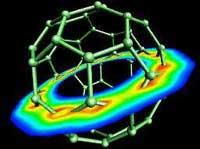Very hot superconductivity
laboratories in the United States (USA) have prepared a material capable of transporting electricity without resistance to 117 K (-96°C).
-96°C is very cold for the common man, but it can be said that it is hot for those who work with superconductors, since superconductivity is visible in many materials but at extremely low temperatures. A few months ago, for example, it was detected that the magnesium diboro compound was superconducting at 39K and was considered a huge discovery.
Many scientists look for superconducting materials above the temperature of liquid nitrogen (-196°C), and one of them is the one presented today in the journal Science. In fact, the liquid nitrogen limit is very important, as it is an economic limitation outside the laboratory. These temperatures can be achieved through such an abundant nitrogen in the air, making it cheap.
Future material

Such an interesting material has been achieved by mixing fulerenes (carbon balls, C 60) with triboromethane and placing the mixture in the heart of a transistor. In 1991, a superconducting product was detected at the Los Alamos National Laboratory in the United States by adding alkaline metals to fulertene crystals. In the late 1990s, Bell labs began working with a new strategy. Instead of transporting electrons, fulerenes suspected that if they carried holes without electrons it was possible to obtain superconductors at high temperature, and they began to concentrate on it.
The material presented today is the result of these investigations. After testing eleven additives, the best results obtained so far have been triboromethanes: Material that transports electricity without any resistance to 117 K. But the research is totally open and the objective pursued is a superconducting material at room temperature.
Buletina
Bidali zure helbide elektronikoa eta jaso asteroko buletina zure sarrera-ontzian











